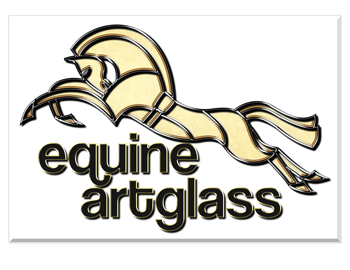Suncatcher, Panel or Overlay? What’s the Difference?
When looking at stained glass on this website you may run across the terms suncatcher, panel or overlay and you’ll probably wonder. . . “What’s the difference?” Looking at the piece you may be able to easily tell or not depending on how the stained glass piece is constructed. So here is the easy explanation and what to look for.
Suncatcher
A suncatcher is any stained glass piece that does not have a geometric shape as it’s outside outline. Our example is the abstract trotting horse. The outline is irregular as the horse moves inside and outside the geometric shape used to accent the piece. Their is no definite shape to this glass piece and therefore it is a suncatcher.
Panel
A panel of any size has a geometric shape to it, whether it is a square, rectangle, triangle, oval or circle a panel has a clearly defined shape with all the glass pieces fitting inside the shape. Our example panel of the horse head clearly shows that the whole piece is fitted within the rectangle shape of this piece. Most stained glass windows and cabinet doors fit within this category.
Overlay
This type of stained glass piece most often uses a geometric single piece of glass, upon which you layer a suncatcher (freeform) piece of stained glass. It adds stability to the top piece and allows you to get a more formal look of a panel. This style can give you some variation in the look of your stained glass piece you are a making or purchasing. Our third picture of a front view of a Peruvian Paso shows a suncatcher overlaid and soldered to a beveled oval. Now if you compare the first picture with this one you will see a similar look to the outline of the glass piece, however, the glass piece in the first picture is made with only one layer of glass, where this piece is made on with two layers, the bevel and then the horse piece. You could also make the trotting abstract piece as an overlay with the horse on the top layer and the swish on the bottom layer.




